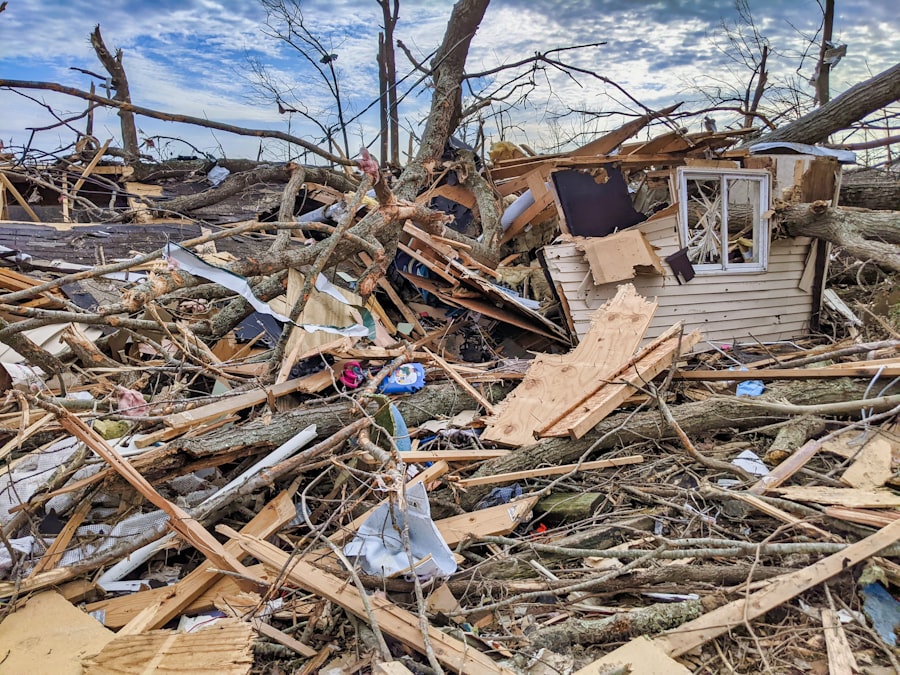In the wake of a devastating tornado, the landscape is often transformed into a scene of chaos and destruction. Homes that once stood proudly are reduced to mere rubble, while trees that provided shade and beauty are uprooted and scattered. The aftermath of such a natural disaster leaves communities grappling with the stark reality of loss.
Buildings are not just structures; they represent memories, lives, and livelihoods. The emotional toll on residents is profound, as they sift through the remnants of their lives, searching for anything that can be salvaged. The physical damage is often accompanied by psychological scars that may take much longer to heal.
Assessing the damage requires a coordinated effort from local authorities, emergency services, and volunteers. Teams are deployed to evaluate the extent of destruction, documenting the impact on infrastructure, homes, and essential services. This assessment is crucial for determining the immediate needs of the community and for planning recovery efforts.
The data collected helps in allocating resources effectively, ensuring that aid reaches those who need it most. As the dust settles, the focus shifts from despair to resilience, as communities begin to come together to support one another in the face of adversity.
Rescue and Recovery Efforts
Search and Rescue Operations
Search and rescue teams, equipped with specialized tools and trained personnel, meticulously comb through debris in hopes of finding survivors. The urgency of these operations is palpable, as every moment counts in ensuring the safety of individuals affected by the disaster.
Recovery Efforts
Once the immediate rescue operations conclude, attention shifts to recovery efforts. This phase involves not only restoring essential services such as electricity and water but also providing medical care and psychological support to those affected. Community centers often become hubs for recovery, offering shelter, food, and resources for displaced families.
Community Resilience
The collaboration between government agencies, non-profit organizations, and local volunteers is vital in this stage, as they work together to rebuild lives and restore hope. The resilience displayed by communities during this time is a testament to the human spirit’s ability to endure even the most challenging circumstances.
Impact on Local Communities

The impact of a tornado extends far beyond physical destruction; it reverberates through the very fabric of local communities. Families are displaced, businesses are forced to close, and schools may be damaged or destroyed. The economic ramifications can be severe, with many residents facing unemployment or loss of income due to the devastation.
Small businesses that serve as the backbone of local economies often struggle to recover, leading to a ripple effect that can hinder community growth for years to come. Moreover, the emotional toll on residents cannot be overlooked. The trauma experienced during such an event can lead to long-term psychological effects, including anxiety and depression.
Community cohesion may be tested as individuals grapple with their losses and seek support from one another. However, in many cases, these challenges can also foster a sense of unity among residents. Neighbors come together to help one another rebuild, share resources, and provide emotional support.
This solidarity can ultimately strengthen community bonds and create a renewed sense of purpose in the face of adversity.
Tornado Preparedness and Safety Tips
| Category | Tips |
|---|---|
| Emergency Kit | Prepare a kit with water, non-perishable food, flashlight, batteries, first aid supplies, and important documents. |
| Safe Room | Designate a safe room in your home, preferably a basement or interior room without windows. |
| Communication | Establish a communication plan with family members and have a battery-powered radio for updates. |
| Warning Signs | Be aware of tornado warning signs such as dark, greenish sky, large hail, and loud roar similar to a freight train. |
| Evacuation Route | Know the evacuation route in your area and have a plan to reach a safe location if necessary. |
Preparedness is key when it comes to mitigating the impact of tornadoes. Communities that prioritize education about tornado safety are better equipped to respond effectively when disaster strikes. Residents should familiarize themselves with local weather patterns and stay informed about tornado watches and warnings issued by meteorological authorities.
Having a designated safe space within homes—such as a basement or an interior room without windows—can significantly increase chances of survival during a tornado. In addition to having a safe location, families should create an emergency kit containing essential supplies such as water, non-perishable food, flashlights, batteries, first aid supplies, and important documents. Regularly reviewing and updating this kit ensures that families are prepared for any situation.
Furthermore, practicing tornado drills can help individuals understand what actions to take during an emergency, reducing panic and confusion when it matters most. By fostering a culture of preparedness within communities, residents can empower themselves and their neighbors to respond effectively in times of crisis.
Rebuilding and Restoration
The journey of rebuilding after a tornado is often long and arduous. It requires not only physical reconstruction but also emotional healing for those affected. As communities begin to assess their needs and priorities, plans for restoration take shape.
Local governments may initiate programs aimed at rebuilding infrastructure while providing financial assistance to families who have lost their homes. This process often involves collaboration with architects and urban planners who specialize in disaster recovery. Restoration efforts also present an opportunity for communities to rethink their approach to development.
Many choose to incorporate more resilient building practices that can withstand future storms better than before. This might include using stronger materials or designing structures that can better absorb wind forces. Additionally, community members may advocate for improved emergency response systems or enhanced public awareness campaigns about tornado safety.
Through these collective efforts, communities not only rebuild but also emerge stronger and more prepared for future challenges.
Support and Aid for Affected Families

In times of crisis, support systems play a crucial role in helping families navigate the aftermath of a tornado. Local organizations, charities, and government agencies often mobilize quickly to provide aid in various forms—financial assistance, food distribution, temporary housing, and counseling services are just a few examples. These resources are vital for families who may find themselves suddenly without shelter or means of sustenance.
Community members also rally together to offer support in any way they can. Fundraising events may be organized to help raise money for those affected by the disaster, while neighbors may volunteer their time to assist with cleanup efforts or provide meals for displaced families. This spirit of generosity fosters a sense of belonging and solidarity among residents during difficult times.
As families begin to rebuild their lives, knowing that they have a network of support can make all the difference in their recovery journey.
The Science Behind Tornadoes
Understanding the science behind tornadoes is essential for improving preparedness and response strategies. Tornadoes form from severe thunderstorms when warm, moist air at the surface meets cooler air aloft, creating instability in the atmosphere.
When conditions are right—such as wind shear that allows these updrafts to stretch vertically—a tornado may form. Meteorologists utilize advanced technology such as Doppler radar to track storm systems and predict tornado formation. By analyzing wind patterns and atmospheric conditions, they can issue timely warnings that save lives.
However, despite advancements in technology, predicting the exact path and intensity of a tornado remains challenging due to their unpredictable nature. Continued research into tornado formation and behavior is crucial for enhancing forecasting capabilities and ensuring communities are better prepared for future events.
Lessons Learned: How to Better Prepare for Future Disasters
The aftermath of a tornado often serves as a catalyst for reflection on how communities can better prepare for future disasters. One key lesson learned is the importance of comprehensive emergency planning at both individual and community levels. Engaging residents in discussions about disaster preparedness fosters a culture of awareness that can significantly reduce panic during emergencies.
Additionally, investing in infrastructure improvements—such as storm shelters or early warning systems—can enhance community resilience against severe weather events. Collaboration between local governments, emergency services, and community organizations is essential in developing effective response strategies tailored to specific regional needs. By learning from past experiences and implementing proactive measures, communities can not only recover from disasters but also emerge stronger and more united in their commitment to safety and preparedness.
In conclusion, while tornadoes bring destruction and despair, they also highlight the resilience of communities and the importance of preparedness.
By understanding the science behind tornadoes and learning from past experiences, communities can build a foundation for resilience that will serve them well in times of crisis.
The recent devastating tornado in Nebraska has once again brought attention to the dangers of living in Tornado Alley. According to tornadoextreme.com, Tornado Alley is a region in the central United States known for its frequent tornado activity. This article explains the meteorological conditions that make this area prone to tornadoes and offers tips on how to stay safe during tornado season. It is crucial for residents in states like Nebraska to be prepared and informed about the risks associated with living in Tornado Alley.

